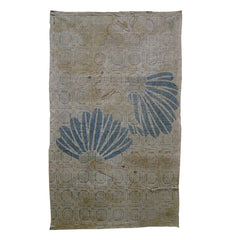A 19th Century Anomaly: Stenciled Back of Wasarasa
mid to late 19th century
22" x 13 1/2", 56 cm x 34 cm
This length of hand woven, hand dyed, hand spun cotton cloth probably dates to the mid nineteenth century and is a wonderful anomaly for its unusual double-sided dyeing.
Featured here is its "wrong" side, the reason being is that this side--which should be blank--shows faintly dyed, large scale Tengu faces accompanied by what appear to be feather fans. There is no apparent reason for dyeing these images onto the cloth, or, maybe more precisely, the reason for dyeing these images onto cloth has long been lost.
The faintness of the images reinforces the age of the piece which is attractive--and if you turn the piece around you will see its proper facing side.
The good looking repeat pattern is a riff on Indian trade cloth. Because the Japanese elite loved the "exotic" Indian trade cloth cotton inspired by or mimicking Indian patterns was produced. This is referred to as wasarasa or Japanese chintz.
Please note the stitching to the lower, right hand corner area of the cloth and note its overall and fully justified patina from age and wear.
Superb and unusual.
Recommended.


